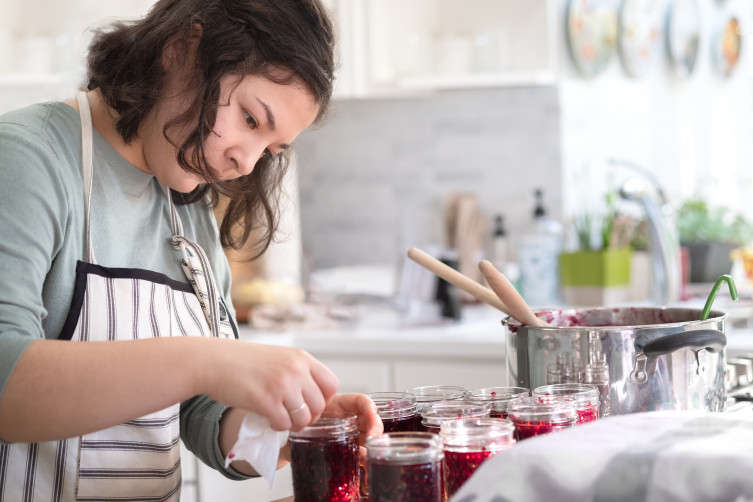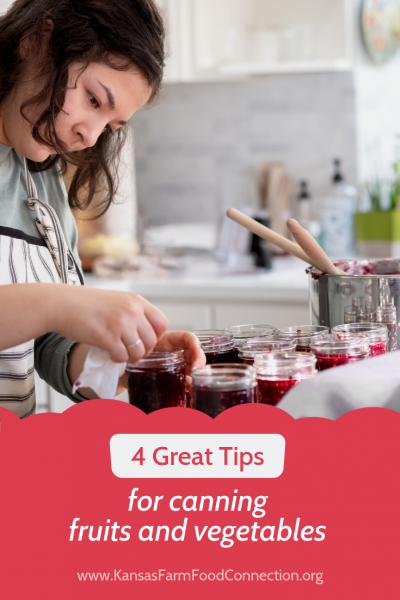4 Tips for Canning Fruits and Vegetables
 Summer means fresh fruits and vegetables galore! Hooray! But what if you get carried away and buy more than you can eat (it happens!)? Or your garden goes gangbusters and you have trouble keeping up? Or you find yourself craving something seasonal when summer’s bounty has passed?
Summer means fresh fruits and vegetables galore! Hooray! But what if you get carried away and buy more than you can eat (it happens!)? Or your garden goes gangbusters and you have trouble keeping up? Or you find yourself craving something seasonal when summer’s bounty has passed?
Set some fresh produce aside for canning!
Your grandma would tell you canning is a great way to preserve food, but there are some things you need to know before you get started—your grandma would tell you this, too.
Food spoils when contaminants like bacteria, yeast and mold multiply, or the food is exposed to oxygen. Canning is all about making sure the food is safe to eat by keeping contaminants out and deliciousness in. Improper canning can result in food that hasn’t been properly preserved and isn’t safe to eat — nobody wants that. Here are four tips to keep in mind.
1. Know How Much Heat to Use
During canning, food is cooked on high heat and vacuum-sealed in containers to kill contaminants and keep them — and oxygen — out.
How much heat canning requires depends on two factors:
- Your altitude
- The acidity of your food
The higher your altitude, the longer you need to heat what you’re canning. This is because water boils at lower temperatures as altitude increases, which means food isn’t exposed to as much heat. By adding cook time, you make up for the lower boiling temperature.
With acidity, think opposites. Foods that are lower in acid require higher heat. Foods that are higher in acid require lower heat.
Foods with high acidity include:
- Tomatoes
- Fruits
- Pickles
Foods with low acidity include:
- Meat (including poultry and seafood)
- Vegetables
- Salsa
2. Determine Your Canning Method
There are two different ways to can at home: water bath or pressure. Each method uses a different type of equipment and is better suited for different types of foods.
As you might guess, in water bath canning, the jars of food are heated in a bath of boiling H2O. This method uses less heat (varying from 212 degrees depending on your altitude) than pressure canning does (which heats to 240 degrees), so it’s better for higher acidic foods, like tomatoes and fruits.
In pressure canning, since foods reach a higher temperature, it’s better for lower acidic foods like meats and vegetables.
3. Pick the Right Equipment
The equipment depends on which method you use and what kind of stove you have. Water bath canners come in stovetop and electric versions. Pressure canners are stand-alone, but can be used like water bath canners if you leave the top off.
If you’re going to use a stovetop canner, the type of stove you have is important. Gas and electric coil stoves work fine for most canners. However, you have to be careful if you have a stove with a smooth top. Smooth-top stoves often have an automatic shutoff if the burner gets too hot. If this happens, your food might not reach the proper temperature, which could be dangerous. Smooth-top stoves also run the risk of cracking under all the weight of the canner, water, jars and food.
If you use a stovetop canner, you also want to make sure your canner fits within the size of the burner. If your canner is larger, your food might not heat properly, which could cause serious safety issues.
4. Select Recipes Carefully
Fun fact: The acidity of produce has changed over time. Therefore, experts recommend only using current recipes for canning (sorry, Grandma). While you might want to try her old tomato jam recipe, tomatoes in her day were more acidic. Using her recipe might call for a lower temperature or shorter cook time, resulting in a potentially dangerous jam today. It’s best to find a similar modern version of her classic recipe. Grandma will understand.
Some recipes account for variations in acidity and include adding vinegar or lemon. Again, this may have changed over time, so it’s best to use something current.
It’s also a good idea to use recipes from a trusted source. Preserving food is all about keeping it safe to eat for months and years to come. Here are some reliable sources with a variety of recipes to choose from:
Canning Resources
If you want to learn more about canning, here are some great resources:
Also, check with local universities and adult education programs. Many organizations, like Kansas State University Research and Extension, offer classes and other resources close to home.
Happy canning!

